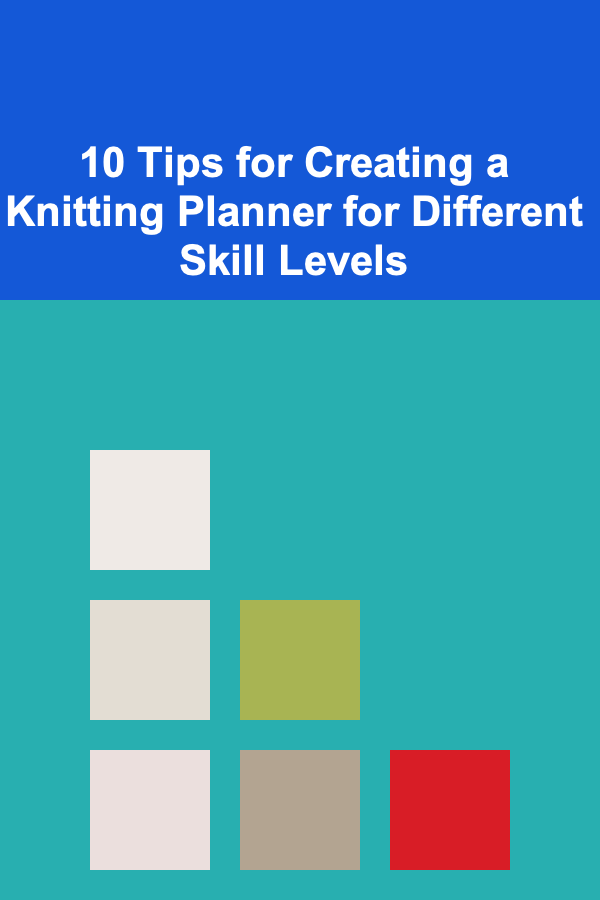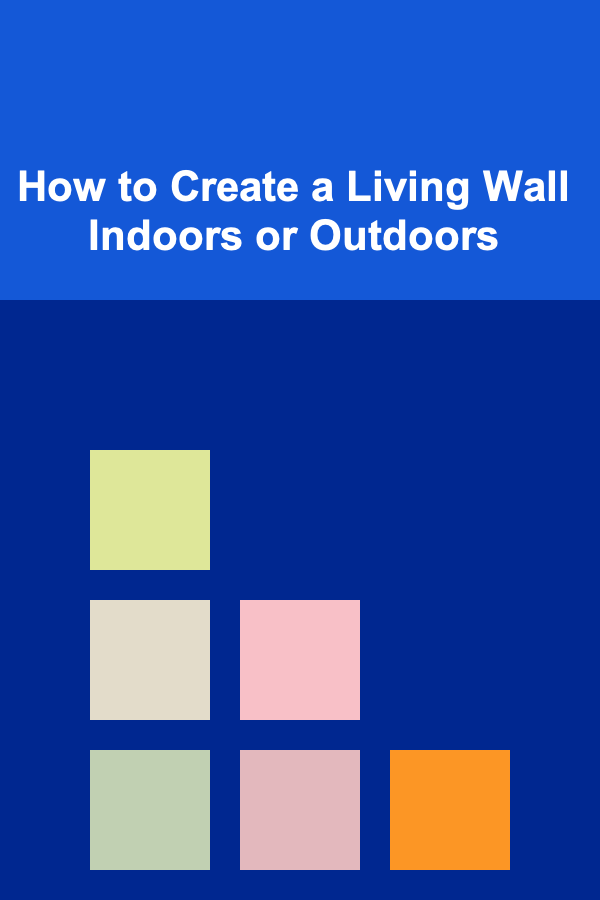
10 Tips for Creating a Knitting Planner for Different Skill Levels
ebook include PDF & Audio bundle (Micro Guide)
$12.99$8.99
Limited Time Offer! Order within the next:

Knitting is a therapeutic and creative hobby that can be as simple as crafting a basic scarf or as complex as creating intricate lace patterns. However, for knitters, organizing projects and tracking progress can sometimes become overwhelming without a structured plan. A knitting planner is an essential tool for any knitter, regardless of their skill level, as it helps keep track of ideas, materials, and project timelines. If you're an aspiring knitting coach, designer, or enthusiast looking to create a knitting planner that caters to different skill levels, this guide will provide you with valuable tips on how to develop a planner that is not only functional but also inspiring for knitters of all types.
Creating a knitting planner requires a balance of practicality and creativity. The following 10 tips will help guide you in creating a comprehensive planner for beginner, intermediate, and advanced knitters, ensuring it is accessible and engaging for all skill levels.
Understand the Different Skill Levels
Before diving into the actual creation of your knitting planner, it's essential to understand the varying needs and challenges that knitters face based on their experience level. Each skill level has distinct characteristics that should be reflected in the planner.
- Beginner Knitters: These individuals are just starting their knitting journey. They often need basic instructions, straightforward patterns, and beginner-friendly techniques. They may also need more space for notes and step-by-step instructions, as well as sections for tracking progress and building confidence.
- Intermediate Knitters: Knitters at this level are comfortable with basic techniques and may have already completed a few projects. They might be looking for more complex patterns, colorwork, or different stitch techniques. The planner should encourage them to experiment with new techniques and help them track project challenges and improvements.
- Advanced Knitters: Experienced knitters have mastered most techniques and can handle intricate patterns with ease. They are likely more interested in exploring new yarns, designing their own pieces, or fine-tuning their skills. An advanced-level planner may include sections for experimenting with custom designs and advanced techniques, such as lacework, cables, and multi-colored projects.
By understanding the unique needs of each skill level, you can create a planner that provides value to every knitter while challenging them to improve.
Design Customizable Sections for Project Tracking
One of the main features of any knitting planner should be a section dedicated to tracking projects. However, each skill level will require different kinds of information.
-
Beginner Project Tracker: For beginners, keep the project tracker simple. Include sections such as:
- Project Name: A place to name the project, helping the knitter stay organized.
- Materials Used: A section for noting down the yarn type, weight, and color, as well as needles used.
- Pattern Source: A space to list where they found the pattern, whether it's a book, online tutorial, or personal design.
- Steps/Instructions: A detailed, easy-to-follow breakdown of the knitting pattern with space for notes and personal observations.
-
Intermediate Project Tracker: For intermediate knitters, include additional fields:
- Techniques Learned: Encourage them to track new techniques they are exploring, such as increasing/decreasing or adding textures.
- Time Spent: A simple way to track how long the project is taking.
- Challenges Encountered: Space to jot down difficulties they face, such as dropped stitches or issues with pattern repeats.
-
Advanced Project Tracker: Advanced knitters might need a more detailed tracker, such as:
- Advanced Techniques Used: Sections for documenting intricate stitches or custom modifications.
- Design Ideas: A place for sketching or describing their own designs or modifications to patterns.
- Results/Outcome: Space for reflecting on the final result, including any changes or improvements for future projects.
Creating customizable sections like these will allow the planner to grow with the knitter, offering just the right amount of space and detail for any skill level.
Incorporate Project Timelines
Having a project timeline is essential for keeping organized and setting achievable goals. Beginners might need a simple timeline, while intermediate and advanced knitters may need to plan for more complex projects. A good knitting planner should help knitters track their progress while maintaining motivation.
- Beginner Timeline: For beginners, timelines should focus on the steps involved in completing a project. You might include daily or weekly check-ins, depending on the complexity of the project. Keep the timeline flexible, encouraging knitters to set reasonable goals, such as completing one row or section per day.
- Intermediate Timeline: For intermediate knitters, the timeline can be more structured, with milestones for reaching certain stages of the project. For example, they could aim to complete a specific technique or stitch pattern by a certain date.
- Advanced Timeline: Advanced knitters often juggle multiple projects at once, so a timeline should be adaptable. This section should allow for tracking deadlines for different stages of the project, whether it's knitting, blocking, or finishing touches.
Incorporating a project timeline keeps knitters motivated and accountable. It encourages consistency and helps track long-term projects, especially for those who want to develop more intricate skills.
Provide Helpful Knitting Resources and References
For knitters of all levels, having easy access to useful resources and references can be extremely helpful. This can include quick access to common knitting terms, abbreviations, charts, and stitch patterns.
- Beginner Resources: Include a basic stitch glossary, common abbreviations, and simple tutorials. It's also helpful to offer tips on how to troubleshoot common issues like dropped stitches or uneven tension. Visual aids, such as illustrations or photos of common mistakes, can also be useful.
- Intermediate Resources: Intermediate knitters might need more in-depth explanations of techniques like increases, decreases, and knitting in the round. Charts and diagrams showing stitch patterns or increases can be beneficial.
- Advanced Resources: For advanced knitters, offer resources for more complex stitch patterns, chart reading, and designing techniques. This might include a section on designing custom cables, lace, or colorwork projects.
Providing these references throughout the planner will allow knitters to quickly reference information, improving their confidence and ability to troubleshoot as they work on their projects.
Offer Inspirational Pages for Ideas and Sketches
A knitting planner should be more than just a place to track progress---it should also inspire creativity. Adding pages dedicated to brainstorming ideas, sketching designs, and recording inspiration can help knitters at every skill level develop their creative side.
- Beginner Inspiration: For beginners, these pages could be filled with simple patterns or color combinations, allowing them to explore different ideas without feeling overwhelmed. Inspirational quotes or motivational tips can also be a great way to keep them engaged and excited about knitting.
- Intermediate Inspiration: Intermediate knitters may want to experiment with different yarns or textures. Offering pages to plan color palettes, record yarn preferences, or sketch new patterns can help them develop their unique style.
- Advanced Inspiration: For advanced knitters, providing space for more detailed sketches, notes about custom designs, and complex stitch ideas can be incredibly valuable. These pages should encourage experimentation and allow knitters to work on personal projects or pattern designs.
By offering inspirational spaces, the knitting planner becomes a tool not just for organization, but also for fostering creativity and expanding skills.
Create a Yarn Stash Tracker
One of the challenges for many knitters is managing their yarn stash. A yarn stash tracker within the planner allows knitters to keep track of the yarn they own, ensuring they don't over-purchase and that they use up what they already have.
- Beginner Stash Tracker: For beginners, a simple tracker that includes yarn type, weight, and quantity can help them stay organized and avoid buying more than they need.
- Intermediate Stash Tracker: As knitters advance, they may start working with different yarns, fibers, and blends. At this level, include a space for yarn texture, colorway, and fiber content, as well as a list of current projects that are using specific yarns.
- Advanced Stash Tracker: Advanced knitters may have a large and diverse yarn collection. Include more sophisticated tracking features, such as the ability to record how much yarn is left after a project, and a section to note which yarns work well for specific techniques or patterns.
This feature will help knitters avoid waste and ensure that they always have the right supplies for their upcoming projects.
Track Gauge and Tension
Gauge and tension are crucial to knitting, particularly for projects where fit matters, such as garments. Including a dedicated section for gauge swatches in the knitting planner helps knitters of all levels monitor and adjust their knitting.
- Beginner Gauge Tracker: Beginners should be introduced to the importance of gauge early on. Include simple instructions on how to knit a swatch and measure tension, along with a space to record the number of stitches and rows per inch.
- Intermediate Gauge Tracker: For intermediate knitters, encourage the practice of checking gauge before starting projects. Offer space for multiple swatches, especially for projects like garments, where accuracy is key.
- Advanced Gauge Tracker: Advanced knitters may be designing their own garments or working with non-traditional yarns. The gauge tracker should allow for more complex tracking, such as variations in stitch patterns or adjustments to fit.
Tracking gauge helps ensure that projects turn out as intended and prevents frustrations caused by incorrect sizing.
Include a Knitting Journal
A knitting journal is an essential addition to any knitting planner, allowing knitters to document their experiences, challenges, and triumphs.
- Beginner Journal: The journal can be a space to record reflections on completed projects, such as how they learned a new technique or overcame a particular challenge.
- Intermediate Journal: Encourage intermediate knitters to reflect on their progress, track how their skills have improved, and note any new techniques they're trying.
- Advanced Journal: For advanced knitters, the journal can serve as a place to plan future projects, document complex design ideas, and track how different techniques work together.
A knitting journal provides an opportunity for knitters to reflect on their journey, track their progress, and celebrate their achievements.
Incorporate a Progress Tracker
Progress tracking is a motivating feature that can be personalized to suit all skill levels. Whether it's for tracking the number of rows completed or checking off specific techniques learned, progress trackers help knitters visualize their growth.
- Beginner Progress Tracker: A simple progress bar for each project or a checklist of tasks (e.g., cast on, knit a few rows, complete a repeat) can motivate beginners to continue moving forward.
- Intermediate Progress Tracker: For intermediate knitters, progress trackers could include more detailed steps, such as completing pattern repeats, finishing a section of a project, or learning a new technique.
- Advanced Progress Tracker: Advanced knitters might use progress trackers to track milestones for complex projects, like finishing a sweater sleeve or completing a lace shawl.
Tracking progress allows knitters to celebrate milestones, big and small, and maintain motivation throughout longer or more complicated projects.
Design for Flexibility
Lastly, ensure that your knitting planner is flexible enough to meet the evolving needs of knitters. As a knitter grows in skill and experience, their needs will change, and the planner should be adaptable.
- Beginner: A simple, guided layout will work best for beginners, but it should still allow space for creativity and growth.
- Intermediate: Intermediate knitters may want to experiment more, so design the planner with sections that can be customized, such as blank pages for notes and sketching.
- Advanced: Advanced knitters might appreciate a more sophisticated and customizable design, with sections for personal project management, design ideas, and future goals.
The flexibility of the planner will ensure that it continues to be a useful tool as the knitter's journey progresses.
By following these 10 tips, you'll create a knitting planner that not only helps knitters stay organized but also encourages them to expand their skills and creativity. Whether they're just starting their knitting adventure or are designing intricate garments, a well-thought-out planner can become an essential part of their knitting practice, helping them to grow and succeed at every stage.
Reading More From Our Other Websites
- [Organization Tip 101] How to Organize Your Workspace for Enhanced Focus
- [Organization Tip 101] Common Mistakes to Avoid When Using Kitchen Cabinet Refacing Kits
- [Home Soundproofing 101] How to Use Mass-Loaded Vinyl (MLV) for Superior Soundproofing
- [Organization Tip 101] How to Designate a Craft Zone in Your Home
- [Needle Felting Tip 101] How to Produce Needle‑Felted Light Fixtures that Diffuse Ambient Lighting Softly
- [Organization Tip 101] How to Create a Monthly Budget That Works for You
- [Home Party Planning 101] How to Plan a Home Party for Every Occasion: Birthdays, Anniversaries, and More
- [Home Rental Property 101] How to Secure Insurance for Your Rental Property
- [Organization Tip 101] How to Use Magnetic Strips for Small Tool Storage
- [Home Budget 101] How to Set Up an Emergency Fund for Home Expenses

How to Create a Living Wall Indoors or Outdoors
Read More
How to Use Magnetic Strips for Storing Metal Beauty Tools
Read More
Mastering Scientific Research: Advanced Strategies for Innovation and Discovery
Read More
How to Master Basic Stir-Frying
Read More
Architectural Design: How to Navigate Client Communication
Read More
10 Tips for a Yearly Financial Health Checkup
Read MoreOther Products

How to Create a Living Wall Indoors or Outdoors
Read More
How to Use Magnetic Strips for Storing Metal Beauty Tools
Read More
Mastering Scientific Research: Advanced Strategies for Innovation and Discovery
Read More
How to Master Basic Stir-Frying
Read More
Architectural Design: How to Navigate Client Communication
Read More